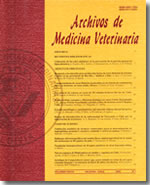Gastrointestinal microorganisms in cats and dogs: a brief review
Main Article Content
Abstract
The gastrointestinal (GI) tract of animals contains different types of microorganisms known as the GI microbiota. The GI microbiota has long been of interest because of its involvement in multiple physiological processes in the host, influencing health or disease. Recent studies have shown that the GI microbiota of cats and dogs is as complex as the one present in humans and other animals, according to state-of-the-art sequencing technologies and other molecular techniques. The GI microbiota includes members of all three main life domains (Archaea, Bacteria, and Eukaryotes), with bacteria being the most abundant and metabolically active group of microorganisms. The stomach of cats and dogs is mainly inhabited by Helicobacter spp., which in dogs may account for as much as 98% of all gastric bacterial microbiota. The small intestine harbors a more diverse microbiota as it contains representatives from at least five bacterial phyla (mainly Firmicutes and Bacteroidetes). The large intestine harbors the most abundant (~1011 bacterial cells per gram of intestinal content), diverse (at least 10 bacterial phyla have been identified) and physiologically relevant group of bacteria in the GI tract. Most bacteria in the large intestine are strict anaerobes that depend on fermentation of non-digested dietary substances to subsist. Although recent studies are shedding light into the complexity of the GI microbiota in cats and dogs, further research is needed to find ways to successfully manipulate GI microorganisms to prevent and/or treat GI diseases.

